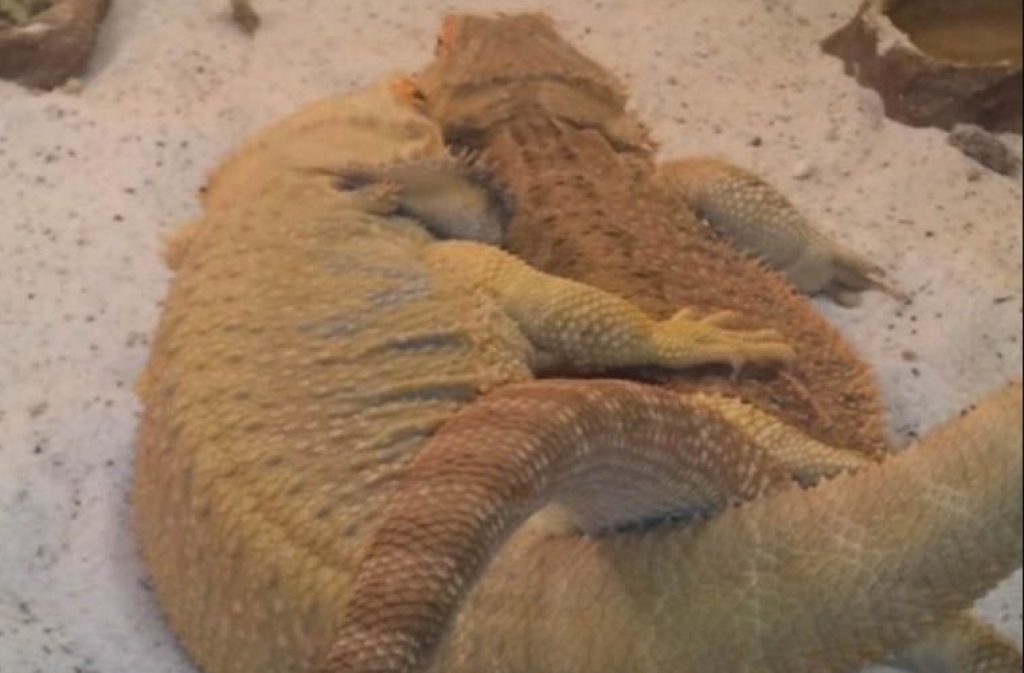Usually, bearded dragons attain sexual maturity when they are aged 1 and 2 years. Their growth rate and influences the exact time when they mature sexually. As they approach sexual maturity, males become more aggressive and display dominance by beard inflation.
Mating often occurs after winter or brumation. You can initiate brumation by dropping their basking temperature and duration of daylights. Once they stop eating, you can begin the winter cooling for 6-8 weeks. Afterward, begin to restore typical temperature and lighting gradually. After they wake up from brumation, they will breed.

1. Copulation
Copulation or mating only occurs after the male has to shown dominance, and the female has conceded, especially after brumation. It begins with courtship rituals that involve the male feet stomping, head bobbing, and arm waving while it is in front of a female.
Afterward, the male will chase the female, bite the backside of her neck, swipe his tail below the female’s tail, and lock her to the copulation position with the help of his hind legs. Copulation will them quickly occur, i.e., for less than a minute.
If your females scratch your vivarium or seem aggressive, she is not ready to mate. Otherwise, a receptive female will bob their head slowly.
Finally, since females have oviductal crypts for storing sperms, they can lay as 15-30 eggs twice from a single instance of mating.
2. Gravid females
As a breeder, you need to know that gravid or egg carrying bearded dragons require more calcium to avoid depletion. They use calcium in making eggshells.
Therefore, ensure you supplement calcium, vitamin D3, and other supplements as you do to baby beardies. Supplementation will prevent metabolic bone disease and other health problems. Otherwise, if gravid females are calcium deficient, their eggs will be bright or semi-clear, and they may not bind well or burst as embryos grow.
When carrying eggs, they will increase in size and later have lumps on their abdomen, which you can feel with your hands.
3. Laying eggs
Typically, females lay a clutch of 10-30 eggs twice from a single mating with larger females laying more eggs in most cases. Their eggs are oval and flexible (with soft shells).
While in the wild, they will find a suitable place, dig a hole, lay and bury the eggs. Afterward, they will leave them unattended.
In captivity, they need a nesting box such as slightly damp but not wet sand, coco fiber, or both and will lay eggs 2-3 weeks after mating.
Signs that they are about to lay eggs include substrate scratching and digging, while some will stop eating as usual.
Provide them with at least an 18-gallon nesting with the 16-inch deep substrate. When gravid beardies are about to lay eggs, they will dig deep burrows for laying eggs.
For nesting purposes, prepare two parts of the horticultural vermiculite to one part of water. The substrate should be moist but not very wet. Not providing them a place to lay eggs may make them suffer from dystocia where they will not be able to pass their eggs.
Egg care and incubation
Once they have laid eggs, carefully dig them and put them in your incubation box with the embryo side facing up. It appears as a pink spot inside the egg.
You can use sand, coarse potting soils, Perlite, or vermiculite substrate that is slightly damper than the nesting box. A typical ratio of vermiculite to water is often 1:1.
1. Are they fertile and healthy?
How do you know a healthy and fertile egg? It is straightforward. A healthy egg turns to chalk white, and it grows during incubation to double its initial size. Those appearing green, yellow may be infertile.
Furthermore, shining a bright light on them in a dark place from the opposite side should enable you to see a pink spot in the eggs with blood vessels. If not fertile, they will appear yellow without veins.
2. Incubation duration and conditions
Incubation periods will vary with bearded dragon species with ideal temperature ranging from mid-20’s°C to low-mid 30’s C.
Temperature variation will swing gender with lower favoring male and higher female hatchlings. While they may have male or female chromosomes, incubation temperature will influence gender.
For instance, when incubated at a higher temperature (34 °C), the hatchlings will be female, while if it occurs at a lower temperature (30 °C), expect a male.
How soon they hatch will depend on temperature, humidity, and other environmental factors. In the wild, it takes between 50-80 days.
